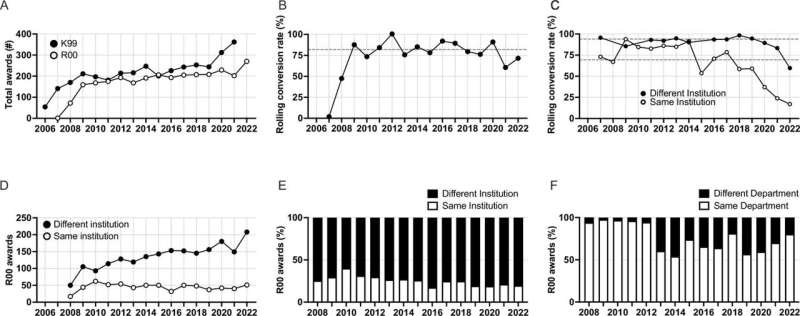This article has been reviewed according to Science X's editorial process and policies. Editors have highlighted the following attributes while ensuring the content's credibility:
fact-checked
trusted source
proofread
Analysis of research grants pipeline illustrates systematic disadvantages

Of the more than 3,000 extramural K99 awards granted between 2008 and 2021, none were to an investigator at a Historically Black College or University (HBCU), based on a new analysis published in eLife.
"I think that data point speaks volumes, especially when you consider that 11 HBCUs have R2-status—signifying high research activity—and several may obtain R1-status, signifying very high research, activity in the next year or two. The inequities are staggering, but unfortunately not surprising," said Nicole Woitowich, Ph.D., Medical Social Sciences and executive director at the Northwestern University Clinical and Translational Sciences (NUCATS) Institute.
Reviewing National Institutes of Health (NIH) K99/R00 awards and the career progression of awardees, investigators also found that researchers with greater mobility, men and those hired at well-funded institutions experience greater subsequent funding success.
Investigators used data from the NIH Grants Management Database to reveal the inequalities that shape faculty funding opportunities and career pathways. Inequalities were found to disproportionately affect women and faculty working at particular institutions, including HBCUs.
"Our hope is that policymakers and administrators at funding institutions take notice and try to support those who are systemically disadvantaged. We know that most people are not surprised by our findings but by getting the hard data out there, we hope that tangible changes can be made," said lead author Daniel Tyrrell, Ph.D., assistant professor of Molecular and Cellular Pathology at the University of Alabama at Birmingham.
"One perspective for university administrators could be that they want to hire more mobile men to increase chances of future funding. An alternative strategy is to better support those with less mobility and women. This can be done through policy around pay equity, leave, childcare, understanding mobility limitations and more."
The research team included Sarah Hengel, Ph.D., Tufts University; Christopher Solis, Ph.D., MBA, Florida State University; Tauras Vilgalys, Ph.D., University of Chicago; and Joel Babdor, Ph.D., University of Pennsylvania. Their collaboration and subsequent publication arose after a Tweet posted by Tyrrell, who shared a preprint of his initial findings.
"When I saw his preprint, I was immediately interested in examining the data by gender," Woitowich said. "I sent him a message, as did my co-authors, expressing interest in this work. We came together, each brining a different analytical lens to this dataset. This is a prime example of how social media can foster collaboration and network building in science."
The NIH Pathway to Independence program is designed to provide up to five years of support through two phases of funding. The initial, or mentored phase (K99) provides one to two years of mentored support to promising postdoctoral research scientists. The K99 phase is followed by up to three years of independent support (R00) contingent on the scientist securing an independent research position.
Analysis showed that the cumulative advantage of K99/R00 funding is stark.
Men who moved to a new institution with large NIH funding portfolios during the R00 phase had the shortest median time to receiving a subsequent major NIH award (4.6 years) and had a greater overall chance of ever receiving a major award (84.6%).
Each cumulative disadvantage increased the median time to receive a major NIH award by about six months and reduced the overall chance to receive subsequent major NIH award by 5% to 6%.
The median time to receive subsequent major NIH awards for K99/R00 awardees that were women that stayed at an R00 institution with smaller NIH funding portfolios was 7.4 years with just a 60% chance to receive a major NIH award.
"These data highlight how important early-career support is for biomedical scientists and speak more broadly to the disparities that persist," Woitowich said. "I think it's important that we capture and evaluate this data so we can at least have a benchmark for progress."
This length of time is critical for tenure-track faculty who typically have between six and seven years to earn tenure, which often hinges on receipt of a major research grant for research-intensive faculty. These cumulative disadvantages may contribute to lower likelihood of receiving promotion and tenure and may contribute to the gender disparities in faculty ranks and in leadership positions.
"There are systemic things that need to be done to help course correct, but there are also small things that can change, too," Tyrrell said "We tend to call the minority of highly-NIH-funded institutions 'prestigious' but this practice propagates the negative belief that the remaining institutions are not prestigious. This is a wrong way of thinking. We, as academics and individuals can make conscious decisions to try to change this perspective and potentially impact this practice."
More information: Nicole C Woitowich et al, Analysis of NIH K99/R00 awards and the career progression of awardees, eLife (2024). DOI: 10.7554/eLife.88984.4


















